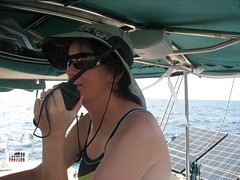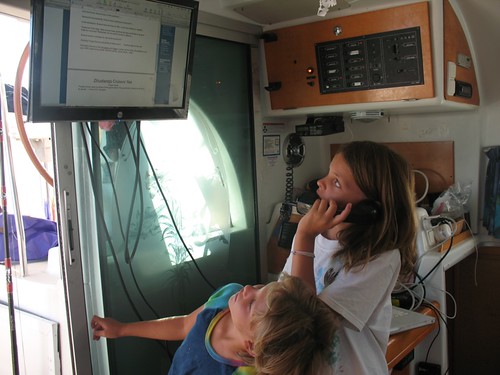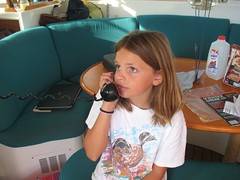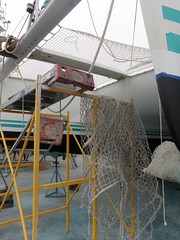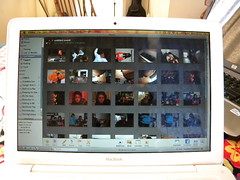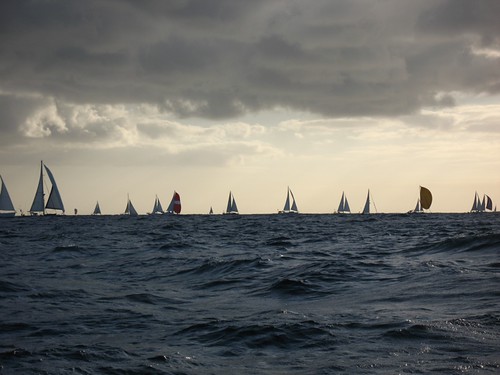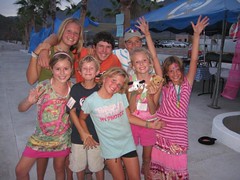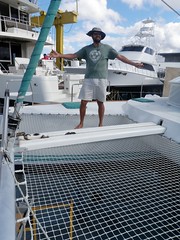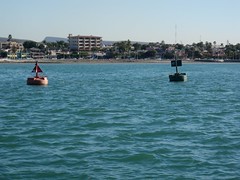Aeron helpfully peeks into the dodger locker, "Cat is here."
DrC grumbles something about fuel from the galley where he is preparing dinner.
Jaime more or less completely unhelpfully notes that she remembered to check her Facebook account before we left the marina three hours ago.
And then there is silence.
In case you haven't been following along, I have three children. Aeron, Jaime, and Mera. We all wait for a few breathless, still moments, the only sound the flapping of the main as it luffs in the gentle swells and off shore breeze. Almost as one, we turn to look at the smudge on the distant horizon.
"I'll look," says Aeron, jumping down off the cockpit seat and scrambling into the port hull.
Jaime, Dean and I don't move. We are all sharing the same, miserable thought. Oh shit. We left Mera behind.
It's not like we haven't done this before. In fact, it is something of a habit, leaving Mera behind. Mera is our quiet, studious, bookish middle child. For years as we learned to drive the boat, we would take Don Quixote out every Thursday night for the Elliot Bay Marina races. Roughly half the time, we'd leave her on the dock and for many of the remaining evenings we could honestly state after sailing for an hour that we didn't actually know whether or not Mera was on board. It got so bad that DrC insisted we put a check list on the helm: dock lines and fenders stowed, instruments on, electrical unplugged, radio on, Mera on board.
Fortunately, the silent miserable tableaux of the three senior crew of Don Quixote is broken mere moments later by a relieved, high soprano voice shouting up, "She's here! She's HERE!"
Maybe we are just rotten parents. If so, we're probably bad pet owners, too. Twice we more or less accidentally left Dulcinea behind. Once we left the dinghy behind. And on one memorable occasion, we kinda sorta accidentally snuck out of an anchorage in the wee hours of the morning abandoning a pair of particularly obnoxious 'buddy boats.'
Yet I must confess that my biggest fear cruising has never been that I would stupidly head off shore for a 2000 nautical mile trip one head short of a full deck. My children are clever, capable souls and can handle being alone for a few hours. At age 5, Aeron proved the point when we drove to the grocery store one day and left her at the marina. As an aside, this was also Mera's fault, as Mera's seat in the van was next to Aeron's. How she could get all the way to the store and into the produce section failing to notice something as loud and noisy as her sister was missing baffles me to this day. A panicky 15 minutes later, we arrived back at the marina and found Aeron eating donuts and entertaining the staff in the office where she had -- quite correctly -- immediately tromped after discovering that her bonehead family had driven off without her.
No, my fear is almost exclusively the loss of one of my beautiful family overboard in the night.
The odds of finding someone -- even someone wearing a life jacket -- in the middle of the ocean at night are astronomically low. If everyone else is asleep when you fall over, the phrase 'zero chance of survival' is not hyperbole. Beacons, personal EPIRBs, and proximity crew alarms all improve your odds, of course. These options were simply not priced in the affordable range a mere five years go, so the Conger family travelled from Seattle to Auckland without them. If we could have, we would have. If you can, do. If you can't...
Well even with all the fancy shmancy gear in the world, surviving a midnight fall off an ocean going yacht is mostly a matter of not doing it. Doctor, it hurts when I do this! Don't do that. My fear of falling informs our boat rules and gear. A simple but well-cared for system of jacklines, harnesses, clips, and life jackets tie the helmsman to the boat no matter what the weather. On passage, no one is allowed to step so much as a toe on the deck without this gear from the time the sunlight turns to burnished gold on the horizon to the moment in the morning where the coffee is steaming and its possible to read a book in the salon without additional light.
And still I am afraid. I still experience panicky moments when I come up at 2 AM for my watch and die a little when I can't instantly track Jaime's movements. Nights when I leap out of my cabin at 10 during DrC's watch, heart pounding, sure he's gone forever. I have tended the boat through 90 knot hurricane winds, managed sails while balanced precariously on the bimini as we pitched in a heaving sea, leaped overboard at midnight to clear a prop with my feet when we were moments from being driven ashore, and watched my children leap like billy goats along a traverse in Zion with a 1000 foot drop on either side. Yet nothing -- absolutely nothing -- scares me like these moments in the night when I know with a certainty that leaves me cold that one of my loved ones is gone.
Our fears can not define the boundary of our existence or the limit of our reach. To watch my girls swim with whales, I have to let them stand watch in the night. To love them -- to let them live -- I have to trust them not to die. It's hard. It's so hard to count heads and come up one short. And yet every night, we do it anyway.
I keep counting and counting and counting until the number is five plus a cat, and every time the moment of relief is pure and fresh and profound.
* * * * * * * * * * * * * * * * * * * * * *
 October's Raft-Up Writers
October's Raft-Up Writers
The topic this month is fear. We all have different fears and different strategies. If you haven't already subscribed to these authors, I encourage you to explore the excellent writing my fellows in Raft-Up:2 Behan sv-totem.blogspot.com
3 Steph www.sailblogs.com/member/nornabiron
4 Stacey http://sv-bellavita.blogspot.com
5 Tammy ploddingINparadise.blogspot.com
6 Ean morejoyeverywhere.com
7 Lynn sailcelebration.blogspot.com
8 Diane www.maiaaboard.blogspot.com
10 Jaye lifeafloatarchives.blogspot.com
11 Verena pacificsailors.com
12 Toast http://blog.toastfloats.com
15 Dana svnorthfork.blogspot.com






